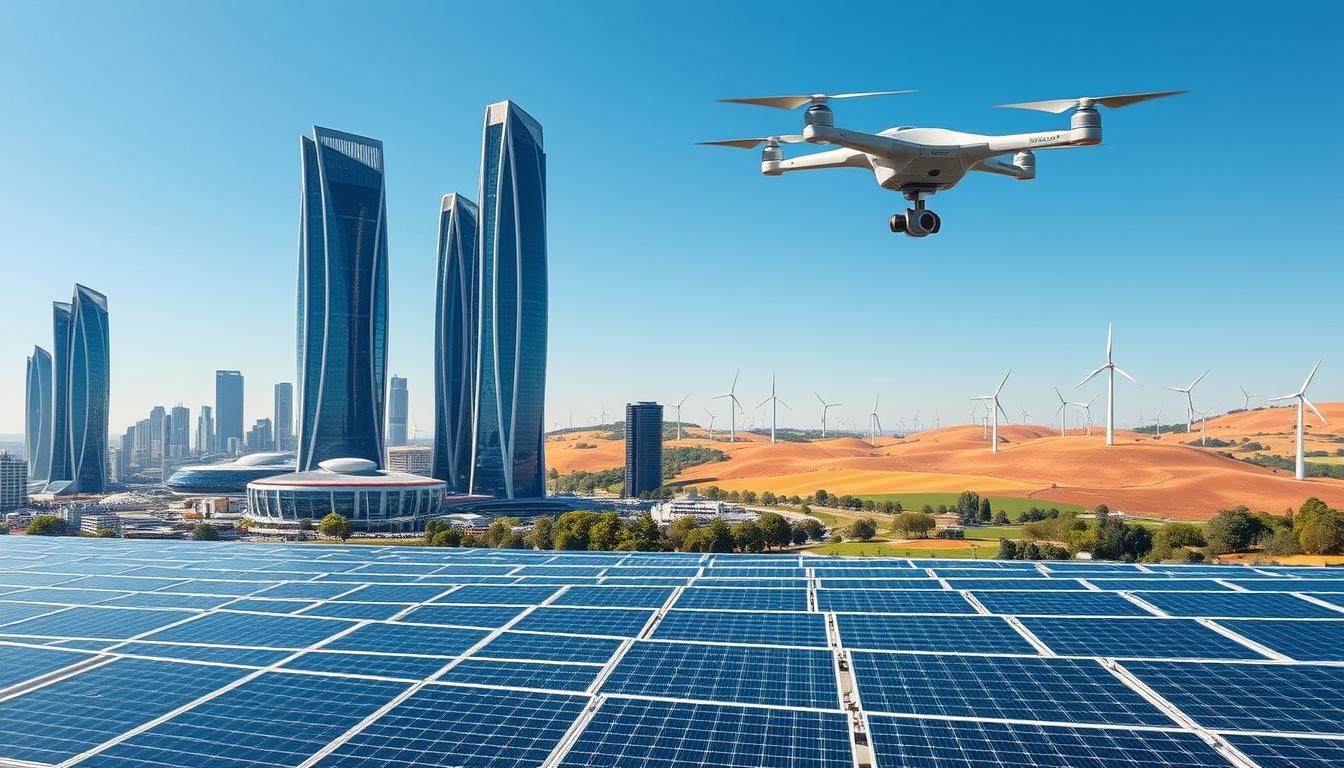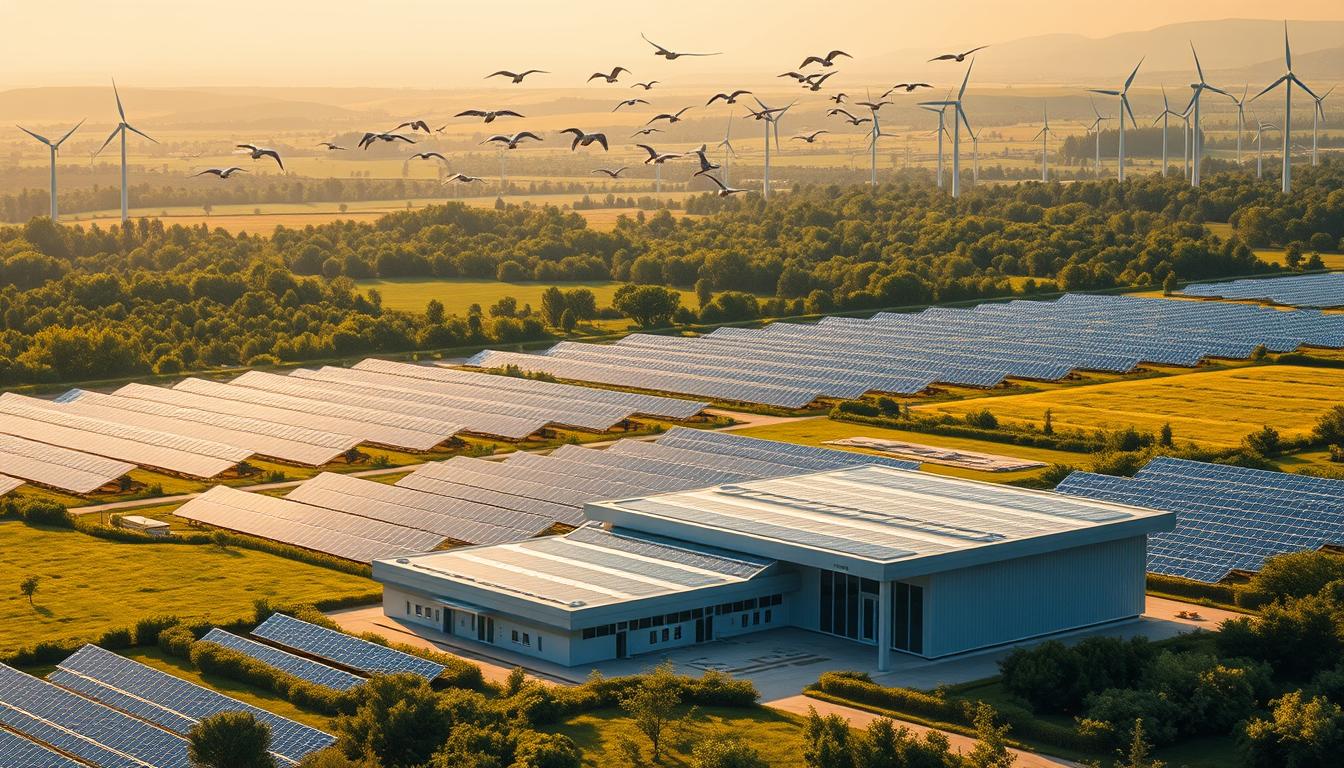Your cart is currently empty!

Can AI Technology Save the Planet from Climate Change?
The Role of AI in Climate Change: Can Technology Save the Planet? Explore applications, challenges, and success stories.
Artificial intelligence is transforming how we approach environmental challenges. By analyzing vast climate data sets, it helps us understand patterns and predict future impacts. This technology offers innovative solutions to reduce carbon emissions and manage energy use more efficiently.
Experts like Jim Bellingham highlight its potential in making climate predictions more accurate. Institutions such as Johns Hopkins University are already integrating AI into their research. Early examples show promise in deploying mitigation efforts faster and more effectively.
Trust and reliability in AI-driven models are crucial for their success. Current trends and expert opinions suggest a bright future for this technology in combating environmental issues. It’s clear that AI could play a pivotal role in shaping a sustainable future.
Table of Contents
Key Takeaways
- AI processes large climate data sets to inform decisions.
- Experts believe it can make predictions more accurate.
- Early examples show promise in faster mitigation efforts.
- Trust in AI models is essential for their success.
- Current trends suggest a bright future for AI in environmental solutions.
Understanding AI’s Impact on Climate Change
Climate strategies have evolved dramatically due to advancements in data analysis tools. Over the decades, machine learning and other technologies have become essential in understanding environmental challenges. These tools have not only improved our ability to predict outcomes but also shaped modern solutions.
Historical Context and Evolution of AI in Environmental Research
In the early days, environmental research relied heavily on manual data collection. This process was time-consuming and often limited in scope. The introduction of machine learning systems changed the game. Scientists could now analyze vast amounts of data quickly, identifying patterns that were previously invisible.
One pivotal moment was the integration of AI into climate modeling. Experts like Jim Bellingham have highlighted how these systems improved predictive accuracy. This shift allowed researchers to focus on actionable insights rather than just raw data.
Key Technologies Shaping Today’s Climate Solutions
Machine learning has become a cornerstone of modern climate solutions. It helps us recognize patterns in complex datasets, making it easier to predict future impacts. For example, renewable energy systems now use AI to optimize power generation and distribution.
Another critical area is the use of AI in managing energy consumption. By analyzing usage patterns, these tools help reduce waste and improve efficiency. This technology is not just a tool; it’s a game-changer in the fight against climate change.
Real-world examples show how historical advancements have led to innovative solutions. From smarter grids to more accurate weather forecasts, AI continues to shape a sustainable future.
The Role of AI in Climate Change: Can Technology Save the Planet?
Innovative solutions are reshaping how we tackle environmental crises. Advanced systems are now at the forefront of reducing carbon emissions and improving climate predictions. These tools not only analyze data but also guide actionable strategies for mitigation.
One example is the use of AI-driven drones in harsh environments. These devices gather critical data from inaccessible areas like the Arctic. This information helps scientists better understand the impact of global warming on polar ecosystems.
Another significant role is in designing advanced renewable energy materials. AI optimizes the efficiency of solar panels and wind turbines. This reduces waste and maximizes energy output, contributing to a more sustainable future.
Here’s a breakdown of how AI is transforming climate management:
| Application | Benefit |
|---|---|
| Data Analysis | Improves predictive models |
| Drone Technology | Gathers data from remote areas |
| Renewable Energy | Optimizes power generation |
| Carbon Reduction | Guides actionable strategies |
These advancements are not just theoretical. They are already making a tangible difference in the fight against climate change. By integrating AI into broader efforts, we can manage resources more effectively and protect our earth.
In conclusion, the role of AI in addressing climate challenges is undeniable. From predictive models to real-world applications, this technology is a game-changer. It offers hope for a sustainable future and a healthier planet.
AI Applications in Climate Modeling and Renewable Energy
Machine learning is revolutionizing how we predict and manage environmental shifts. By analyzing vast datasets, it enhances our ability to forecast weather patterns and optimize renewable energy systems. These advancements are making a significant impact on our efforts to combat climate change.
Improving Climate Models with Machine Learning
Modern climate simulations rely heavily on machine learning to improve accuracy. For example, institutions like Johns Hopkins University use these tools to refine predictions based on evolving data. This approach helps us better understand long-term climate trends and prepare for future challenges.
One key benefit is the ability to process complex datasets in less time. This efficiency allows researchers to focus on actionable insights rather than raw data. As a result, predictive models are becoming more reliable, guiding mitigation efforts effectively.
Enhancing Efficiency in Renewable Energy Systems
AI is also transforming how we manage renewable energy. By analyzing usage patterns, it reduces waste and optimizes power generation. For instance, windmill designs are now enhanced through data-driven innovations, increasing their efficiency and reducing carbon emissions.
Another example is the optimization of solar panel performance. Machine learning algorithms analyze weather data to predict energy output, ensuring maximum resource utilization. These advancements are not just theoretical; they are already making a tangible difference in the fight against climate change.
In summary, machine learning plays a dual role in both predictive modeling and real-world applications. Its integration into renewable energy systems is a game-changer, offering cost-saving measures and sustainable solutions for a healthier planet.
Scaling AI for Environmental Solutions: Emerging Challenges
Expanding the use of intelligent systems for environmental solutions comes with significant hurdles. While these tools offer immense potential, their large-scale deployment faces technical, resource, and energy-related challenges. Addressing these issues is critical to ensuring their positive impact on our planet.

Technical Hurdles and Resource Constraints
One major challenge is the need for more efficient processors. Current systems require vast computational power, which can strain existing infrastructure. Autonomous capabilities in harsh environments, like the Arctic, also pose significant technical issues. These limitations slow down data collection and analysis.
Resource constraints further complicate scaling efforts. Data centers consume enormous amounts of energy and water, raising concerns about their environmental impact. Balancing innovation with sustainability remains a pressing issue for organizations worldwide.
Environmental Impact of Large-Scale Deployments
Deploying intelligent systems on a large scale involves trade-offs. While they can reduce carbon emissions, their own energy consumption and waste generation must be addressed. For example, data centers account for a significant portion of global energy use. This paradox highlights the need for greener solutions.
Current research emphasizes the importance of optimizing these systems. Innovations like renewable-powered data centers and energy-efficient algorithms are gaining traction. These efforts aim to minimize the environmental footprint while maximizing benefits.
Potential Solutions and Enhanced Oversight
To overcome these challenges, collaboration between governments, organizations, and researchers is essential. Policies promoting energy-efficient technologies and stricter oversight can ensure a positive net impact. For instance, integrating renewable energy into data centers is a promising step forward.
Here’s a summary of key challenges and potential solutions:
| Challenge | Solution |
|---|---|
| High energy consumption | Renewable-powered data centers |
| Water usage in data centers | Efficient cooling systems |
| Technical limitations in harsh environments | Autonomous, ruggedized systems |
| Resource strain | Optimized algorithms and hardware |
By addressing these issues, we can scale intelligent systems effectively. This ensures their role in combating environmental change remains beneficial and sustainable.
Data Integration and Advanced Predictive Modeling
Integrating diverse data sources is transforming how we predict and respond to environmental shifts. By combining satellite observations with machine learning, we gain deeper insights into complex climate patterns. This approach is revolutionizing the way we model and forecast environmental changes.
Satellites play a crucial role in gathering critical climate data from remote regions. These observations, when analyzed using advanced technology, help fill gaps in areas that are otherwise difficult to monitor. This integration ensures more accurate and comprehensive predictive models.
Here’s how data integration is making a difference:
- Combining satellite data with machine learning improves the accuracy of climate predictions.
- Advanced algorithms decipher complex environmental patterns, providing actionable insights.
- Enhanced models support better decision-making in climate policy and resource management.
One example of this integration is the use of autonomous sensors in the Arctic. These tools collect data on ice melt and temperature changes, which are then analyzed to predict future impacts. This process highlights the importance of combining multiple data sources for a holistic view.
“The synergy between satellite data and machine learning is a game-changer in climate science. It allows us to see patterns that were previously invisible.”
Improved data integration also addresses resource allocation and energy efficiency. By optimizing renewable energy systems, we can reduce waste and maximize output. This approach not only mitigates climate change but also ensures a sustainable future.
In summary, integrating diverse data sets with advanced technology is key to tackling environmental challenges. It enhances predictive accuracy, fills data gaps, and supports effective climate action. This synergy is shaping a more resilient and sustainable world.
Designing Resilient Infrastructure with AI: Success Stories
Smart systems are reshaping how we build infrastructure to withstand environmental challenges. These tools are not just theoretical; they are already making a tangible difference in creating sustainable, resilient structures. From urban planning to remote monitoring, advanced technologies are transforming the way we approach infrastructure design.
Real-World Examples of AI-Driven Climate Initiatives
One standout example is the use of autonomous drones in the Arctic. These devices collect critical data on ice melt and temperature changes, providing insights into the impact of global warming. This information helps scientists and policymakers design infrastructure that can withstand extreme conditions.
Another success story comes from sustainable urban planning. Cities like Copenhagen are using technology to optimize energy use and reduce carbon footprints. By analyzing data from sensors and satellites, these systems ensure efficient resource management and long-term sustainability.
Here’s how AI is driving change in infrastructure projects:
| Project | Benefit |
|---|---|
| Arctic Monitoring | Provides data for resilient design |
| Urban Planning | Optimizes energy and resource use |
| Predictive Maintenance | Reduces costs and improves durability |
| Renewable Energy Integration | Enhances efficiency and sustainability |
These initiatives highlight the role of technology in building a sustainable future. By integrating advanced tools into infrastructure projects, we can create systems that adapt to environmental change and support thriving communities.
In conclusion, the impact of smart systems on infrastructure design is undeniable. From data-driven insights to proactive maintenance, these tools are shaping a more resilient and sustainable world. By leveraging these innovations, we can ensure a healthier planet for generations to come.
Global Policies and Regulatory Perspectives on AI and Sustainability
Global collaboration is essential to harness the potential of intelligent systems for environmental sustainability. Policymakers worldwide are grappling with the need to balance innovation with ethical and regulatory safeguards. This section explores international compliance, ethical considerations, and the challenges of integrating environmental strategies into national policies.
International Compliance and Ethics in AI Deployment
Robust global policies are critical to regulate the environmental impact of intelligent systems. Organizations like the UNEP have emphasized the importance of integrating environmental considerations into national strategies. These guidelines ensure that technology deployment aligns with sustainability goals.
One major issue is the lack of standardized regulations across countries. While the EU has implemented strict data privacy and environmental disclosure laws, other regions lag behind. This disparity creates challenges for multinational organizations striving for compliance.
Ethical dimensions also play a significant role. Deploying intelligent systems in environmental contexts raises questions about data usage and transparency. Policymakers must address these concerns to build public trust and ensure equitable access to resources.
“Ethical AI deployment is not just a regulatory requirement; it’s a moral imperative for a sustainable future.”
Here’s a summary of key regulatory steps taken globally:
- The EU mandates environmental impact assessments for technology projects.
- The United States encourages voluntary disclosures on energy consumption.
- UNEP promotes international cooperation to develop unified standards.
These efforts highlight the importance of global collaboration in addressing environmental challenges. By sharing insights and best practices, nations can create a cohesive framework for sustainable technology deployment.
In conclusion, balancing innovation with environmental safeguards remains a pressing issue. Policymakers must prioritize ethical considerations and international compliance to ensure a sustainable future. Through unified efforts, we can harness the full potential of intelligent systems for environmental management.
Balancing AI’s Environmental Footprint with Sustainable Deployment
Balancing the benefits of advanced systems with their environmental costs is crucial for sustainable progress. While these tools offer innovative solutions to pressing challenges, their energy consumption and waste generation must be addressed. This section explores how we can reconcile these benefits with their environmental impact.

Minimizing Energy Consumption and Greening Data Centers
Data centers are the backbone of advanced systems, but they consume vast amounts of energy and water. For example, a single data center can use as much electricity as a small town. This high demand strains resources and contributes to greenhouse gas emissions. Addressing this issue is essential for sustainable deployment.
One effective strategy is transitioning to renewable energy sources. Companies like Google and Microsoft are leading the way by powering their data centers with solar and wind energy. This reduces their carbon footprint and sets a precedent for others to follow.
Another approach is optimizing cooling systems. Traditional methods require significant water usage, but innovations like liquid cooling and air-side economizers are more efficient. These advancements minimize waste and lower operational costs.
Here’s a summary of key strategies:
- Switching to renewable energy sources to reduce carbon emissions.
- Implementing energy-efficient cooling systems to conserve water.
- Designing modular data centers for scalability and reduced waste.
Real-world examples demonstrate the potential of these initiatives. For instance, Facebook’s data center in Sweden runs entirely on hydroelectric power. This not only lowers its environmental impact but also serves as a model for sustainable practices.
In conclusion, balancing the benefits of advanced systems with their environmental costs is essential. By adopting green data centers and energy-efficient practices, we can ensure these tools contribute positively to our planet. The challenge lies in advancing technology while protecting the environment for future generations.
Future Trends and Innovations in AI-Driven Climate Action
The future of climate action is being reshaped by groundbreaking innovations in intelligent systems. These advancements are not just theoretical; they are already making a tangible difference in how we address environmental challenges. From predictive modeling to renewable energy optimization, the potential for transformative change is immense.
One key area of innovation is in machine learning and predictive modeling. These tools are becoming more sophisticated, enabling us to forecast environmental shifts with greater accuracy. For example, institutions like the UN are leveraging these technologies to develop resilient strategies for climate adaptation. This approach ensures that we are better prepared for future challenges.
Another exciting trend is the integration of intelligent systems into energy management. By analyzing usage patterns, these tools optimize renewable energy systems, reducing waste and maximizing efficiency. For instance, solar and wind farms are now using AI to predict energy output and adjust operations in real time. This not only lowers costs but also supports sustainable energy goals.
Here’s a breakdown of how these innovations are driving progress:
| Innovation | Benefit |
|---|---|
| Predictive Modeling | Enhances climate forecasts |
| Energy Optimization | Reduces waste and costs |
| Autonomous Monitoring | Provides real-time data |
| Policy Integration | Supports global sustainability goals |
Case studies from recent global conferences like COP 28 highlight the expanding role of these tools in climate resilience. For example, AI-driven drones are being used to monitor deforestation and track carbon emissions. These applications provide actionable insights, helping policymakers make informed decisions.
Looking ahead, the long-term impact of these developments on global climate policy is promising. By integrating intelligent systems into broader strategies, we can create a more sustainable and resilient future. The challenge lies in scaling these innovations while minimizing their environmental footprint.
In conclusion, the future of climate action is bright, thanks to the transformative potential of intelligent systems. From predictive modeling to renewable energy optimization, these tools are driving progress and offering hope for a healthier planet. By embracing these innovations, we can ensure a sustainable future for generations to come.
Conclusion
Scientists and organizations are leveraging advanced systems to address pressing climate issues. Their work is transforming how we understand and respond to environmental challenges. From predictive modeling to renewable energy optimization, these tools are driving meaningful change.
Throughout this article, we’ve explored the power and challenges of intelligent systems in climate action. While these technologies offer immense potential, their development must align with sustainable goals. Regulated deployment ensures they contribute positively to our planet’s health.

Despite challenges, the promise of these systems is clear. They provide insights into complex patterns, helping us manage resources more effectively. Organizations worldwide are already using them to reduce energy waste and improve efficiency.
Looking ahead, ongoing innovations will continue to evolve. They inspire further action and collaboration across industries. By integrating these tools into broader strategies, we can create a sustainable future for generations to come.
I urge decision-makers and citizens alike to support technology with a conscience. Together, we can harness its potential to protect our planet and ensure a healthier tomorrow.
References and Next Steps
Addressing environmental challenges requires innovative tools and collaborative efforts. To further explore this topic, I’ve compiled a list of resources from UN News, UNEP, and insights from experts like Megan Mastrola. These references provide valuable insights into how advanced systems are shaping sustainable solutions.
For those interested in taking action, here are some next steps. First, individuals can support policies promoting energy-efficient technologies. Second, organizations should invest in machine learning models to optimize resource management. Finally, governments must foster international collaboration to address global climate issues.
Emerging policy frameworks are shaping the future of environmental management. By integrating these tools into broader strategies, we can reduce waste and minimize carbon emissions. Continued dialogue between scientists, policymakers, and the public is essential for balanced progress.
In conclusion, leveraging innovative systems offers hope for a sustainable future. By adopting forward-thinking strategies, we can protect our planet’s health and ensure a better tomorrow.


